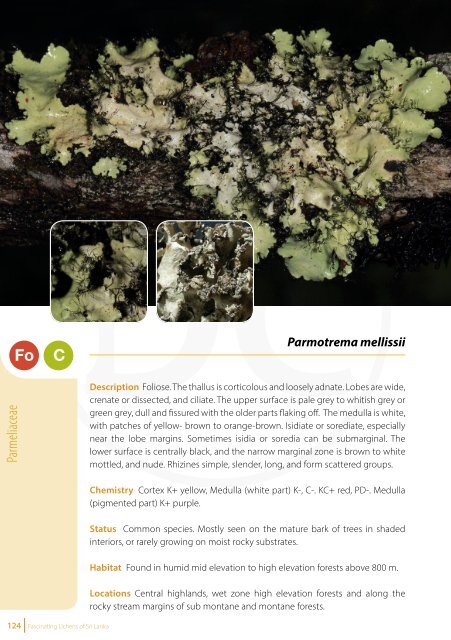Create successful ePaper yourself
Turn your PDF publications into a flip-book with our unique Google optimized e-Paper software.
Fo<br />
C<br />
Parmotrema mellissii<br />
Parmotrema tinctorum Palm ruffle lichens<br />
VC<br />
Fo<br />
Parmeliaceae<br />
Description Foliose. The thallus is corticolous and loosely adnate. Lobes are wide,<br />
crenate or dissected, and ciliate. The upper surface is pale grey to whitish grey or<br />
green grey, dull and fissured with the older parts flaking <strong>of</strong>f. The medulla is white,<br />
with patches <strong>of</strong> yellow- brown to orange-brown. Isidiate or sorediate, especially<br />
near the lobe margins. Sometimes isidia or soredia can be submarginal. The<br />
lower surface is centrally black, and the narrow marginal zone is brown to white<br />
mottled, and nude. Rhizines simple, slender, long, and form scattered groups.<br />
Chemistry Cortex K+ yellow, Medulla (white part) K-, C-. KC+ red, PD-. Medulla<br />
(pigmented part) K+ purple.<br />
Status Common species. Mostly seen on the mature bark <strong>of</strong> trees in shaded<br />
interiors, or rarely growing on moist rocky substrates.<br />
Habitat Found in humid mid elevation to high elevation forests above 800 m.<br />
Locations Central highlands, wet zone high elevation forests and along the<br />
rocky stream margins <strong>of</strong> sub montane and montane forests.<br />
Description Foliose. The thallus is loosely adnate, corticolous or saxicolous and<br />
large (even up to 20 cm across). Most conspicuous species <strong>of</strong> this genus in <strong>Sri</strong><br />
<strong>Lanka</strong>. The lobes are broad and wide (10-20-30 mm). Lobes do not have marginal<br />
cilia, but are covered with granular to cylindrical, branched isidia. The dull upper<br />
surface varies from pale grey to darker grey. The lower surface is centrally black,<br />
with a very broad tan to brown naked edge.<br />
Chemistry Cortex K+ yellow, Medulla PD-, K-, KC+ red, C+ blood red. This lichen<br />
is easily identified by the broad, pale isidiate lobes and C+ red reaction.<br />
Status Very common species in <strong>Sri</strong> <strong>Lanka</strong>. On mature bark <strong>of</strong> trees and on rocks<br />
in all sorts <strong>of</strong> habitats. Cosmopolitan, and widespread throughout the tropical<br />
and temperate regions.<br />
Habitat Common on bark. In humid mid elevation to high elevation forest<br />
above 600 m.<br />
Locations Avissawella to Hatton, Kegalle to Kandy, abundant in the central<br />
highlands, Matale, Knuckles, Horton Plains, Pidurutalagala, Sabaragamuwa hill<br />
range, Ratnapura, Haputale, Bandarawela, Badulla and Nuwara Eliya.<br />
Parmeliaceae<br />
124 <strong>Fascinating</strong> <strong>Lichens</strong> <strong>of</strong> <strong>Sri</strong> <strong>Lanka</strong><br />
<strong>Fascinating</strong> <strong>Lichens</strong> <strong>of</strong> <strong>Sri</strong> <strong>Lanka</strong> 125















